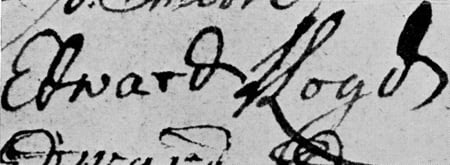The first recorded news of Lloyd’s Coffee House in Tower Street, London dates from February 1688 when Edward Lloyd was 41 years of age. It is believed he was a Welshman and that he moved to the area in 1680. At the end of 1691, Lloyd moved to No. 16 Lombard Street, the very centre of the maritime business district.
A maritime hub
Few London merchants had their own offices or counting-houses at this time. Instead, they transacted much of their business at the Royal Exchange, a meeting place in the City for businesses and merchants. News and information were collected in the social atmosphere of the coffee houses which became centres for specialised interests. Lloyd’s was fast attracting all those concerned with shipping and he fostered this interest by holding maritime auctions and collating information.
In 1696, Lloyd decided to cater for this thirst for news by publishing a paper entitled Lloyd’s News, three times a week. The newspaper came to an abrupt end in February 1697, when Lloyd had a brush with a libel action because of the addition of some text by his printer. However he continued to supply his customers with the intelligence he gathered.
The coffee house continued to prosper and Lloyd’s name was put forward for nomination as a Common Councillor for Langbourn Ward in 1710. He was unsuccessful, but the proposal alone shows that he had become a man of considerable wealth and reputation. His failure can probably be attributed to poor health.
Early in 1713, Lloyd made a will naming his daughters Mary, Abigail, Elinor and Handy, and third wife, Martha. On 28th January, he added a codicil, assigning the lease of his coffee house to his head waiter, William Newton. Events moved swiftly thereafter. Handy Lloyd married William Newton on January 30, and on February 15, 1713, Edward Lloyd died. When Handy died in 1720 the Lloyd family ceased to have any interest in the business.
 Edward Lloyd signature
Edward Lloyd signature
A tale of two Lloyd’s
Successive proprietors of the coffee house continued to specialise in providing customers with up-to-date and accurate information about shipping and the marine insurance market. In 1727, the coffee house passed into the hands of Thomas and Elizabeth Jemson. Elizabeth was the sister of Handy’s second husband.
Thomas Jemson founded Lloyd’s List in 1734. This paper, unlike the earlier Lloyd’s News, was at first given entirely over to shipping intelligence, taken to be a sign of the growth of the underwriting business in Lloyd’s.
When the Society for the Registry of Shipping, which was to become Lloyd’s Register, was founded in 1760, Samuel Saunders was the proprietor of the coffee house. On his death in 1763 it became clear that it had owed much of its good management over the past eight years to him.
From then on the reputation of the coffee house declined. To the annoyance of respectable customers, gambling, speculation and stockjobbing escalated, leading them to procure new premises at No. 5 Pope’s Head Alley in 1769. The new house was opened on March 21 in that year as New Lloyd’s Coffee House and a week later the first edition of New Lloyd’s List was issued.
Some 79 merchants, underwriters and brokers decided that the rooms were not really large enough for comfort; in 1771 each agreed to subscribe £100 to build an entirely new establishment but the project came to nothing. It was not until 1774, that the members of Lloyd’s moved into their new quarters at the Royal Exchange and began to transact business solely as underwriters.
From Lloyd’s Coffee House to No. 71
In 1786 the Society for the Registry of Shipping moved from Lloyd’s Coffee House at No. 16 Lombard Street, to No. 4 Sun Court, Cornhill. By 1797 the Register Book had 215 subscribers and the Society was run by an organising committee of 11 members. In this year the Society moved to No. 4 Castle Court, Birchin Lane. The committee updated the classification system but the changes disadvantaged ships built outside London. Protesting subscribers set up their own register called the Society of Merchants, Shipowners and Underwriters, and issued the New Register Book of Shipping for the first time in 1799. They were based first at No. 3 St Michael’s Alley, and then from 1812 at No. 5 Old Broad Street in the City.
By 1815 the two register books were falling out of favour. A joint register was needed as an impartial measure of quality. From 1820 ship owners started to press both parties to remedy the situation. Eventually an agreement was reached in 1834 with the meeting of the first Committee of Lloyd’s Register of British and Foreign Shipping. The reconstituted Lloyd’s Register took up residence at No. 2 White Lion Court, Cornhill.
There was some concern about whether or not the Society would survive as subscribers fell and funds shrank, but by 1854 it had steadily built up its reserves to more than £20,000 (£1.3 million as at 2010). Towards the end of the 19th century the ever-increasing size of Britain’s merchant fleet and the demand for more rigorous standards in the construction of iron and steel steam ships meant that once again Lloyd’s Register had outgrown its premises.
It was decided to commission a purpose-built building and land was purchased at 71 Fenchurch Street. Find out more about Lloyd's Register in London.





